‘Find alternatives to development freeze to deal with glut’

KUALA LUMPUR (Feb 12): Development freeze is never a good thing to do because free trade is interrupted, according to Rahim & Co International Sdn Bhd estate agency director Robert Ang.
“When you freeze, and subsequently announce that it is going to be a selective freezing, it opens up a lot of questions. Other measures should be employed while banks should conduct their own feasibility studies on the development projects.
* Market to ‘remain flat with greater focus on affordable housing’
“If a developer has the money to develop and to hold on to the development, why not allow the developer to develop? Freezing is never a good option,” he told reporters at a media conference in conjunction with the release of the “Rahim & Co Research – Property Market Review 2017/2018” today.
Rahim & Co International director for research and strategic planning Sulaiman Akhmady Mohd Saheh added that the independence of feasibility studies for development projects by banks must be looked at.
“The banks need to do the study themselves, not just based on the property valuer appointed by the borrower so that they are not just looking from the borrower’s or developer’s point of view.
“The move to curb new supply is applauded but we also need to look at how the market will absorb the existing supply,” he added.
To recap, a development freeze was issued by the government in November 2017 to temporarily freeze developments priced from RM1 million with the aim of alleviating the oversupply of malls, office buildings, condominiums and serviced apartments priced above RM1 million. What was initially a blanket ban across the country later turned out to be a case-by-case evaluation to be done by the government.
On the high-end residential market, Sulaiman said the segment will remain flat this year, with prices having already seen about 10% drop in transacted prices over the past 18 to 24 months, or about 15% to 20% lower than the original asking prices in the secondary market.
According to Rahim & Co executive chairman Tan Sri Abdul Rahim Abdul Rahman, the high-end residential segment now has a new and lower average price range.
“A few years back, high-end residential properties in Kuala Lumpur city centre were priced at RM2,500 psf and beyond. However, these prices have gone down.
“I think generally, prices for the high-end market now range around RM1,500 psf and above. People will most probably not pay for anything more than RM1,800 psf,” he said.
Meanwhile, oversupply concerns remain in the office and retail segments. With an incoming supply of 18 to 20 million sq ft of office space over the next few years, pressure will be seen on occupancy rates and rental rates.
In the retail segment, the average occupancy rate of the existing 69.8 million sq ft retail space in the Klang Valley stood at 85.2%. Another 18.2 million sq ft is expected to become available over the next four years, adding more pressure on mall owners.
“In addition, the growth of e-commerce and mobile shopping trends has forced mall operators to restrategise their malls as not only a place to shop, but a venue of experience and entertainment as well,” said Sulaiman.
He added that the industrial sector will pick up, thanks to e-commerce and the growth of digital economy.
“With the proliferation of e-commerce and the establishment of the Digital Financial Trade Zone (DFTZ), industrial properties are expected to be on the radar of many players in the years to come, especially for logistic and warehousing,” he said.
Never miss out
Sign up to get breaking news, unique insights, event invites and more from EdgeProp.
Latest publications
Malaysia's Most
Loved Property App
The only property app you need. More than 200,000 sale/rent listings and daily property news.
